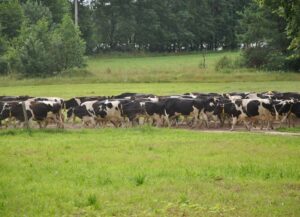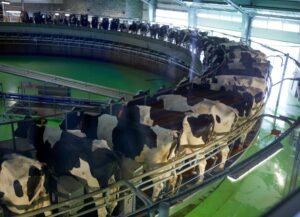Andrés Haro
Feed represents the highest expense on dairy farms, as a result the industry seeks to get animals that use feed more efficiently without affecting their productivity.
There are different ways to measure feed efficiency or how animals convert feed into products, for example the residual feed intake, which is a simple method based on linear regression. However, with the growth of technology applied to farms, more powerful monitoring systems have been developed that allow more data to be obtained from each cow, and practically 24 hours a day.
The abundant information recorded by these systems can be integrated into more complex models such as the NRC (National Research Council) net energy model that allows for a more accurate estimate of feed efficiency.
The authors of a study (Seymour et al., 2020) used data collected through biometric technologies to assess changes in feed efficiency at the beginning of the lactation, and to develop a new measure of feed efficiency based on the NRC’s net energy model. To accomplish this, they used data between 0 and 150 days in milk (DIM) from 40 primiparous Holsteins of 2.08 years on average at calving.
The parameters recorded daily were feed intake, corrected milk production, weight, and body condition. The data obtained were used to model with the following feed efficiency indexes: gross feed efficiency, income over feed costs, residual feed intake, residual intake of net energy, and net energy for lactation efficiency.
Gross feed efficiency: the relationship between milk production and feed intake
Dry matter intake (DMI) increased constantly up to 75 DIM where it stabilized at approximately 20 kg/day. Corrected milk production peaked at 32 kg/day at 40 DIM and began to decline from 135 DIM on. Body weight decreased to up to 35 DIM and then started improving consistently until the end of the study, as could be expected during normal growth of primiparous cows. Body condition score decreased from 3.6 to 3.1.
The highest gross feed efficiency was achieved at the beginning of the lactation, when the increase in corrected milk production exceeded that of DMI, with an average of 2.7 kg of corrected milk/kg of DM. As DMI increased and corrected milk production stabilized, gross feed efficiency decreased and stabilized at approximately 1.6 kg of corrected milk/kg of DM.
Correlations between the data indicated that gross feed efficiency was associated with a reduction in DMI.
Income over feed costs increased on average from $15.9 at the beginning of the lactation to a peak of $19.0 at 14 DIM. This value remained relatively stable until 125 DIM and at the end of the experiment it decreased, as corrected milk production was reduced.
Residual intake
Neither residual feed intake nor the residual net energy intake was correlated with any of the model factors (DMI, body weight, etc.).
The residual intake showed no appreciable bias and tended to be within 2.5 kg of DM/day for residual intake of feed and 5 Mcal of net energy of lactation (NEL)/day for NE residual intake. Estimates however fluctuated daily, and the expected intake for some animals was substantially different from the observed intake.
Net energy dynamics
The average maintenance requirements throughout the experiment were 9.5 to 10 Mcal/day. It was estimated that body reserves contributed approximately 10 Mcal of NEL/day at the start of the lactation. This value constantly decreased up to 55 DIM, where it reached approximately 1 Mcal/day. The average net energy balance consistently increased from 10 Mcal/day at the start of the lactation, to approximately 1 Mcal/day at 75 DIM.
Results in average net energy efficiencies indicated that NEL increased to 77% by 40 DIM, and subsequently decreased to 70% at 150 DIM. In addition, NEL showed weak correlations with the variables, except for corrected milk, suggesting that lactation efficiency tends to increase simultaneously with corrected milk production and is independent of body size or DMI.
Relationship between the study period and feed efficiency
An important aspect to consider in estimating feed efficiency is the time during which that efficiency is measured. In this study it was observed that feed efficiency changed daily regardless of the measure used, something that should come as no surprise since while average feed intake may be relatively stable over time, the cows adjust their daily intake to meet nutrient needs.
Conclusions
Regardless of the measure used, feed efficiency changed over the study period, but most measures showed similar trends in day-to-day efficiency variations.
The authors stated that, with sufficient data, the net energy model can estimate feed efficiency similarly to traditional regression methods, and with greater biological significance.
Reference
Seymour, D.J., Cánovas, A., Chud, T.C.S., Cant, J.P., Osborne, V.R., Baes, C.F., Schenkel, F.S., Miglior, F. 2020. The dynamic behavior of feed efficiency in primiparous dairy cattle. Journal of Dairy Science: 103(2): 1528-1540.
© 2021 Dellait Dairy Knowledge Center. All Rights Reserved.











